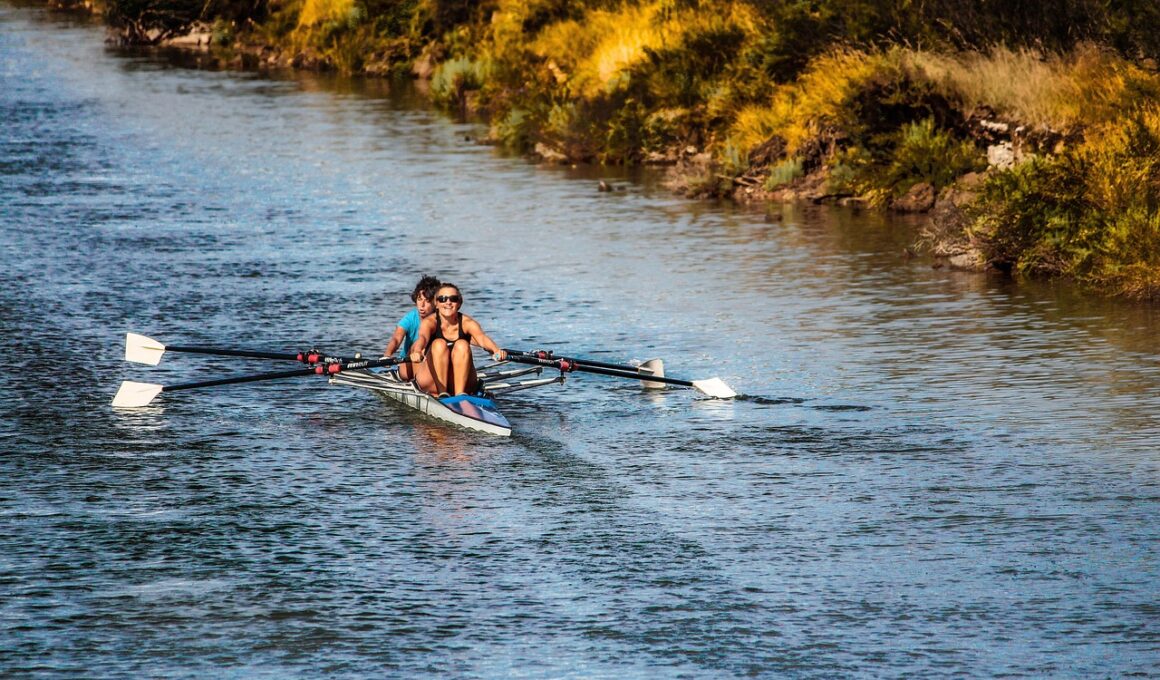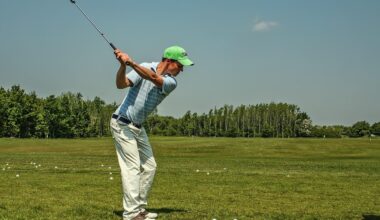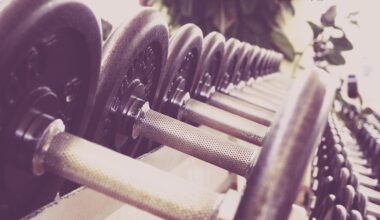Switching Positions: What Rowers Should Know
Understanding rowing positions is crucial for teamwork and performance. Each rower contributes uniquely based on their position. The stroke seat primarily leads the stroke rhythm, setting the pace for the rest. Meanwhile, the bow seat handles steering, maintaining direction and balance. Understanding these roles helps rowers adjust when switching positions, ensuring seamless transitions. Training enables rowers to grasp technical nuances relevant to each position. Communication among teammates is key, allowing rowers to convey their feelings about cadence and technique. Additionally, rowers should frequently practice in different seats to understand diverse responsibilities better. This adaptability fosters versatility and enhances overall team dynamics. Embracing the discomfort of change can lead to personal growth and better crew synergy. Focus on mastering various techniques allows rowers to become well-rounded athletes capable of filling gaps in any configuration. Transitioning into different positions can illuminate individual strengths and weaknesses. As a result, rowers can appreciate their teammates’ challenges and, in turn, support one another in optimizing performance. Ultimately, effective switching builds camaraderie, essential for achieving shared goals in any rowing environment.
There are several characteristics essential for successful rowers, especially when switching positions among various roles. First is balance; each rower must maintain stability in the boat while adjusting their technique to fit a different position. This skill surpasses mere physical strength; it requires mental focus and awareness of body alignment. Second, timing during the stroke informs the effectiveness of rowing efforts. Adapting to a new timing style can be difficult but is crucial in maintaining boat speed. Additionally, rowers should work on endurance, ensuring they can handle the physical demands of their new roles without compromising overall performance. Empathy also plays a significant role; understanding each other’s challenges builds a supportive team environment. Encouraging peer feedback strengthens connections, promotes learning about strengths and weaknesses, and fosters teamwork. Furthermore, rowers should engage in various drills that target the specifics of each position. Awareness of unique criteria for seats broadens perspectives and enhances adaptability. Finally, rowing requires open-mindedness; rowers should approach position switches as opportunities for growth. Embracing differences not only enhances individual skills but also enriches the overall performance of the team.
The Importance of Versatility in Rowing
Versatility is a defining trait for rowers, especially when they are asked to switch positions frequently. A versatile rower can adapt to different roles seamlessly, ensuring the boat maintains optimal performance across races. Practicing multiple roles fosters not only personal growth but also contributes significantly to the overall performance of the crew. Understanding various positions allows rowers to appreciate distinct responsibilities, thus improving teamwork and communication. Additionally, versatility can mitigate challenges arising from unexpected situations, such as injuries or varying crew configurations. Rowers who can fill different roles help maintain stability, ensuring the crew remains competitive. Moreover, adapting to new positions assists rowers in identifying which skills are essential for success in different contexts. Regular practice in diverse roles enhances muscle memory associated with specific skills and techniques. Training together in various configurations cultivates familiarity, making transitions smoother. Versatile rowers are invaluable assets to any crew, adding depth and resilience to team dynamics. Furthermore, this adaptability promotes a sense of shared responsibility, as each member can contribute in multiple ways to collective goals in competitive events.
In addition to being versatile, rowers should focus on several techniques when switching positions within a crew. One key technique is effective communication; clear communication ensures precision and minimizes misunderstandings during transitions. Establishing signals or cues enables rowers to synchronize their movements, ensuring smooth execution of strokes. Another critical aspect is understanding body mechanics; rowers must adjust their posture and movements for new roles. This involves recognizing how shifts in weight distribution affect balance and stability on the water. Next, rowers should emphasize rhythm; maintaining consistent timing while switching positions enhances overall performance. This consistency allows for improved coordination among crew members, essential in achieving optimal speeds. Practicing drills enables rowers to develop necessary muscle memory, ensuring their bodies learn the nuances of each position. Furthermore, both mental and physical conditioning contribute to a successful transition between roles; rowers need to stay physically fit while cultivating a positive mindset. Embracing constructive feedback fosters an environment of growth, encouraging peers to learn from each other. Finally, staying attentive to adjustments during practices reinforces adaptability and sharpens technical skills that enhance competitive readiness.
Crew Dynamics and Position Changes
Crew dynamics play a vital role in effective rowing, especially when positions change. Understanding team synergy enhances overall performance, as relationships among crew members significantly impact collaboration and resilience. Rowers should prioritize fostering trust and camaraderie, which are essential foundations for adapting to role switches. As members exchange roles, encouraging an inclusive atmosphere mitigates potential tensions or uncertainties. Open communication is crucial, ensuring that rowers express their thoughts about adjustments in a supportive environment. Next, having regular team-building exercises cultivates a sense of unity, enabling rowers to work and adapt together more effectively. Conflicts may arise during transitions, so developing conflict-resolution strategies helps maintain positive dynamics. Additionally, efficient decision-making contributes to smooth transitions between roles; timely support from teammates can ease pressure on individuals adjusting to new positions. Moreover, forming support systems enables rowers to lean on one another during challenges, with experienced members guiding novices. In this way, crews can prepare for any situation, fostering resilience and adaptability. Finally, practicing together consistently under varying configurations enhances teamwork and enhances personal growth for all members of the crew as evolving dynamics are embraced.
Coaches play an instrumental role in guiding rowers as they navigate position changes, ensuring that the entire crew develops effectively. They observe individual strengths and weaknesses, offering personalized feedback that allows rowers to hone their skills based on assigned roles and transitions within the crew. Coaches should focus on providing ongoing technical instruction regarding techniques needed for different positions, ensuring every rower comprehends distinct demands. Furthermore, creating training programs that emphasize flexibility enables rowers to experience various roles throughout the season. Exposure to different positions broadens skill sets and promotes understanding of team dynamics. Coaches should also encourage self-reflection, prompting rowers to analyze their performance in each role and identify areas for improvement. Additionally, fostering a growth mindset within the crew opens up pathways for creativity in addressing challenges when switching positions. Engaging in regular evaluations helps highlight crew members’ progress and adaptations to transitional changes. As rowers grow and adapt, maintaining consistent communication with coaches ensures that feedback is utilized effectively. Overall, coaches can enhance the adaptability of crews, teaching rowers that flexibility is essential for success in competitive rowing.
Conclusion: Embracing These Lessons
Ultimately, embracing the lessons learned from switching positions in rowing is crucial for growth and success. Each transition enhances skills, strengthens teamwork, and promotes understanding among rowers, leading to a more cohesive unit. This adaptability fosters a culture of collaboration, enabling crews to support each other effectively in navigating challenges. Regular practice across different positions cultivates not only personal growth but also deeper connections, allowing rowers to communicate efficiently during races. Additionally, commitment to versatility nurtures a supportive environment where everyone strives towards shared goals, rooted in trust and understanding. The principles learned through position switches highlight the importance of empathy, resilience, and adaptability. These qualities enable rowers to thrive under shifting conditions, instilling confidence as they face various racing scenarios. Furthermore, cultivating open communication channels encourages diverse perspectives, pushing crews toward continuous improvement. Rowers should view position changes as opportunities for growth, gaining insight into their capabilities and those of their teammates. Ultimately, adopting these lessons empowers crews to achieve their competitive objectives while fostering a profound sense of camaraderie and purpose, solidifying their dedication to the sport of rowing.
Rowing is a sport that looks simple on the surface but requires incredible teamwork and understanding of each individual’s roles, especially when positions change. As rowers switch roles, they must become adaptable and embrace new challenges that come their way. It is evident that each seat in a rowing boat has its specific responsibilities; thus, understanding these nuances becomes crucial. Transitioning smoothly between roles enhances both personal skills and team dynamics. Coaches play a significant role, ensuring that rowers receive adequate training to navigate their responsibilities effectively. They must foster an environment where open communication allows rowers to express their feelings and ask questions regarding changes. This helps minimize frustration and confusion during races. Through practice, rowers become familiar with both their unique techniques and those required by different positions. Building a flexible mindset allows rowers to thrive, regardless of where they are placed in the boat. Commitment, trust, and camaraderie imbue the crew with a strong sense of purpose as they train together. Overall, approaching position transitions with enthusiasm and positivity will lead to improved outcomes for both the individual rower and the crew.


